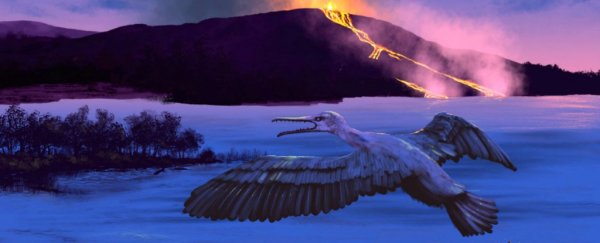A new type of large, prehistoric bird has just been unearthed in the Canadian Arctic.
A team of geologists from the University of Rochester discovered the new species, which is approximately 90 million years old, and published their findings this week in the journal Scientific Reports. The discovery places the bird among the oldest avian records ever found in the Northern hemisphere.
The bones of the bird, named Tingmiatornis arctica, show that it probably looked a bit like a cross between a large seagull and a cormorant, a large aquatic bird, and was likely a similar size with a wingspan of over a metre (3.2 feet).
The name of the genus Tingmiatornis loosely translates to "those that fly" from the word "Tingmiat" in the Inuktitut language, which is spoken in the central and eastern Canadian Arctic. Tingmiatornis arctica also had sharp teeth and features that allowed it to dive.
Along with other fossils from previous expeditions, the new bird helps paint a clearer picture of the ecosystem that would have existed some 93.9 to 89.8 million years ago in the Canadian Arctic. It could also provide further evidence of the intense global warming that scientists think may have taken place over that time - and even help us paint a clearer picture of the future of climate change.
 The Tingmiatornis arctica bird fossil. Credit: John Tarduno
The Tingmiatornis arctica bird fossil. Credit: John Tarduno
How climate records can help us prepare for the future
Building historic climate records helps scientists determine how different species and ecosystems are affected by climate change. The way different species are distributed around countries can help predict the effects too.
"Before our fossil, people were suggesting that it was warm, but you still would have had seasonal ice," said John Tarduno, the chair of the Department of Earth and Environmental Sciences at the University of Rochester and the leading scientist on the expedition, in a statement.
"We're suggesting that's not even the case, and that it's one of these hyper-warm intervals because the bird's food sources and the whole part of the ecosystem could not have survived in ice."
 The area in the Canadian arctic where the fossil was found. Credit: Google Earth/Richard Bono/Rory Cottrell
The area in the Canadian arctic where the fossil was found. Credit: Google Earth/Richard Bono/Rory Cottrell
By looking at fossil and sediment records, the team determined that Tingmiatornis arctica would have lived in a volcanic environment which would have been busy with turtles, champsosaurs and crocodile-like reptiles. This is very different to the Arctic temperatures you find there now.
'What that world could look like, a world without ice at the arctic'
"The fossils tell us what that world could look like, a world without ice at the arctic," said Richard Bono, another member of the team who is a PhD candidate in earth and environmental sciences at the University of Rochester.
 An artist's rendering of Tingmiatornis arctica. Credit: Michael Osadciw
An artist's rendering of Tingmiatornis arctica. Credit: Michael Osadciw
Tingmiatornis arctica fossils were found above lava fields, which would have formed from a series of volcanic eruptions. When these volcanoes pumped carbon dioxide into the Earth's atmosphere, it caused a greenhouse effect, which allowed large birds like Tingmiatornis arctica to thrive.
The environmental clues are the biggest indicators the team has to explain why the bird was found where it was.
"It's there because everything is right," Tarduno said. "The food supply was there, there was a freshwater environment, and the climate became so warm that all of the background ecological factors were established to make it a great place."
This article was originally published by Business Insider.
More from Business Insider:
